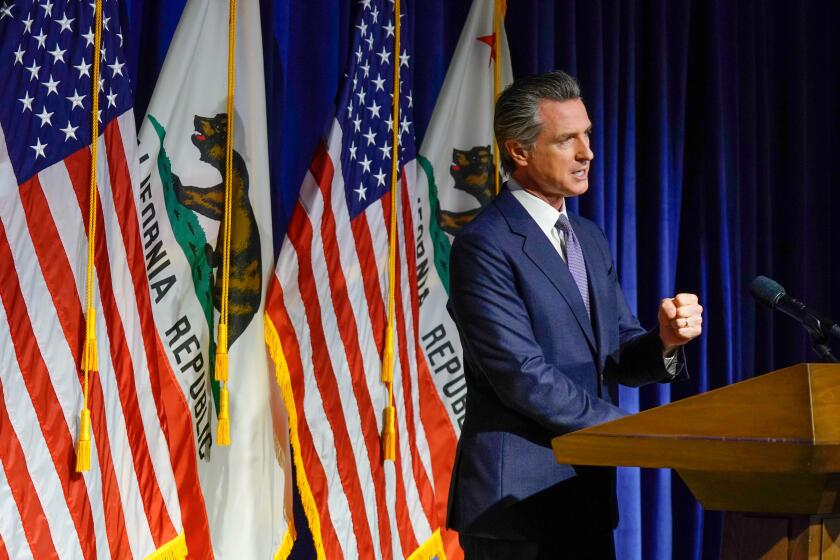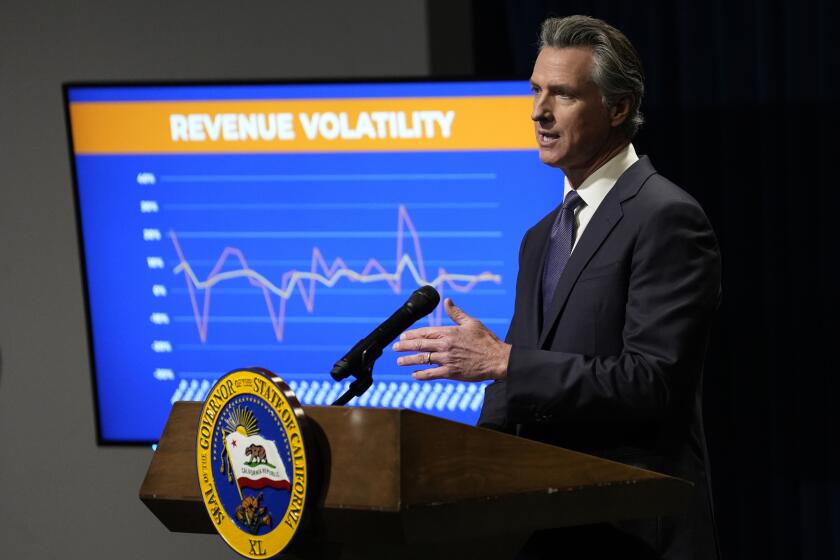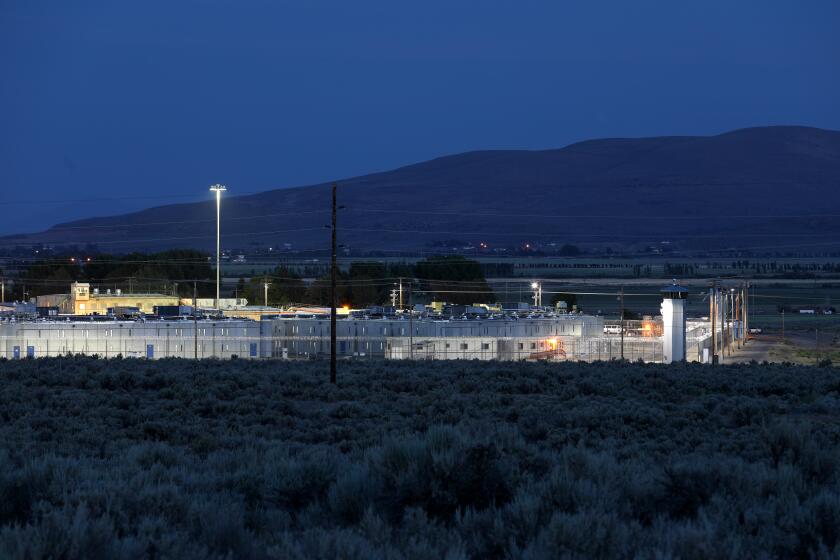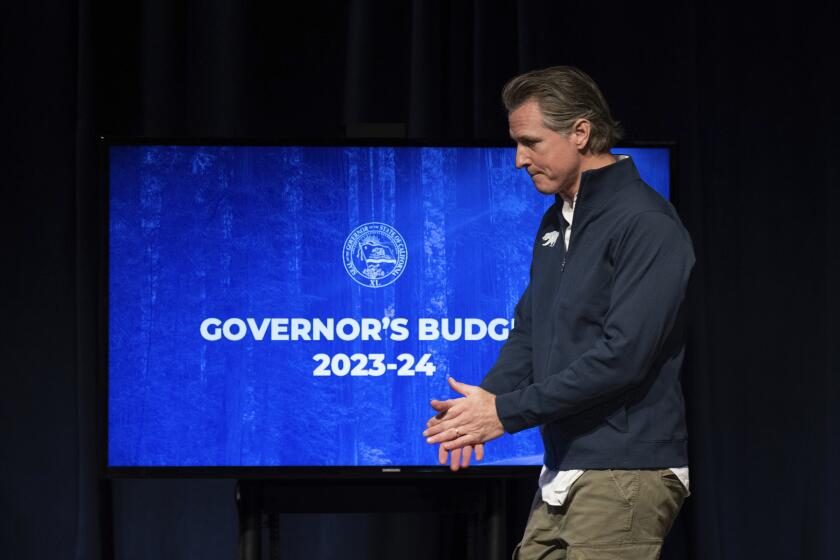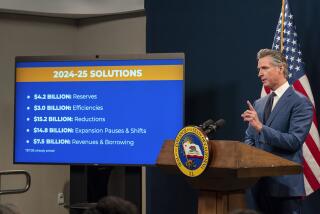What to know about Gov. Newsom’s plan to offset California’s $45-billion deficit
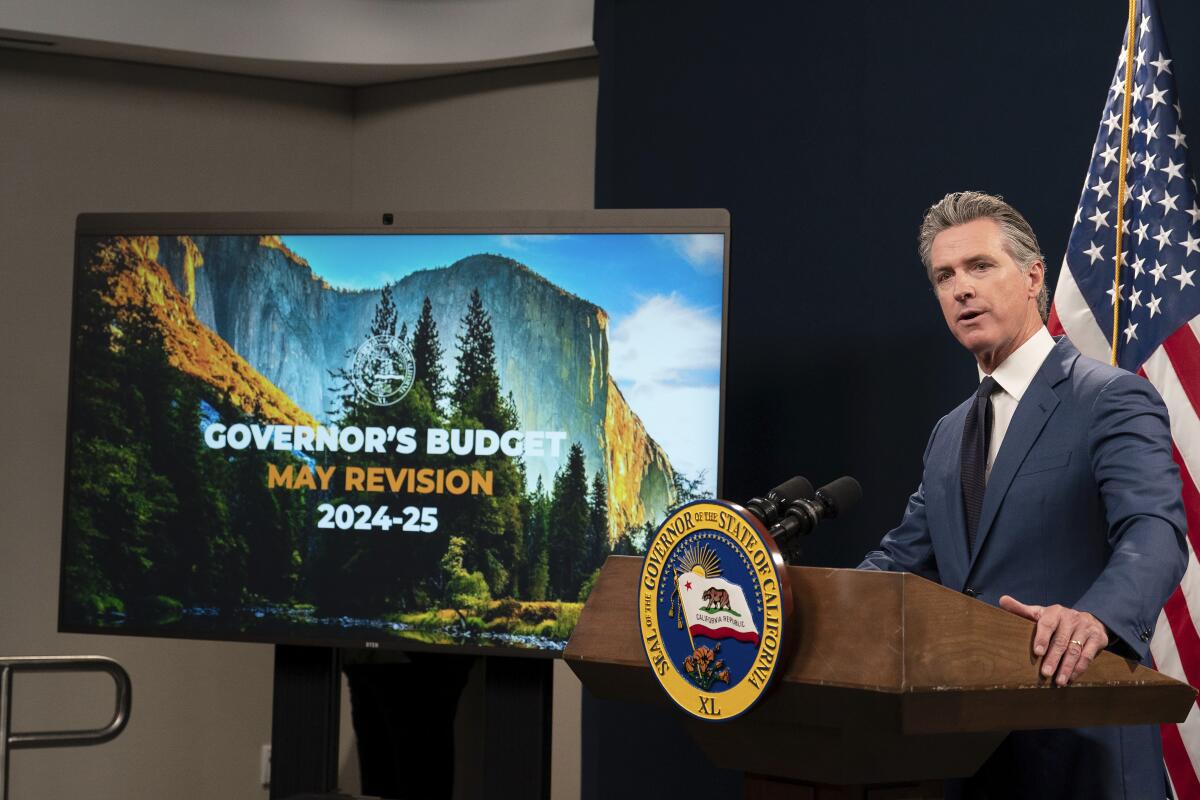
Faced with a $44.9-billion budget deficit, Gov. Gavin Newsom described a plan to shrink the size of state government and slow his progressive policy agenda by eliminating 10,000 vacant state jobs, pausing an expansion of subsidized childcare and cutting billions in funding for climate change programs.
Newsom’s revised $288-billion budget proposal, announced Friday, projected California’s deficit to be $7 billion more than the shortfall his administration expected in January. The grim forecast was driven by lower than projected state revenues, continuing a pendulum swing from the fiscal boom of the COVID-19 pandemic.
“These are things we worked closely with the Legislature to advance,” Newsom said of the cuts. “None of this is the kind of work you enjoy doing, but you’ve got to do it. We have to be responsible. We have to be accountable.”
Newsom’s plan to close the deficit relies on $17.3 billion in savings from budget cuts he and lawmakers agreed to in April and using $4.2 billion from the state’s rainy day fund and budget reserves for the upcoming fiscal year.
The proposed spending reductions Newsom touched on Friday also reverse and slash an additional $8.2 billion in funding in 2024-25.
Newsom’s proposal includes $3.6 billion less for programs related to fighting climate change, said H.D. Palmer, a spokesperson for the Finance Department. The plan would also cut $2 billion over two years from a program to expand internet connectivity to underserved homes, businesses and community institutions.
The governor’s revised budget proposal, which includes updated revenue projections after the state income tax filing deadline, typically jump-starts negotiations with Democratic leaders in the Senate and Assembly over a final fiscal plan for the upcoming year. The state Constitution requires lawmakers to approve the state budget by June 15.
An ‘incomplete’ plan
The governor’s budget plan released Friday was incomplete compared to prior years. The administration provided only a 50-page summary of his proposal, compared to the more detailed, 260-page document Newsom released in January.
Newsom’s budget news conference was originally scheduled for next Tuesday, the deadline for the governor to share his revised budget with the state Legislature. But Newsom is flying to Rome that day to speak at a climate conference at the Vatican and bumped his presentation up to Friday.
The change left the state Department of Finance, the fiscal arm of his administration, short on time to finalize a full budget summary, and additional documents, Palmer said. More information, his aides said, will be made available when additional documents are made public on Tuesday.
Facing tough financial choices to close a budget shortfall, Gov. Gavin Newsom is proposing cuts to programs that benefit foster kids, public defenders and more
How bad is the budget problem?
Newsom cast California’s current financial situation as a return to normal after the federal government provided trillions of dollars in funding to individuals, families, businesses and state governments during the COVID-19 pandemic, payouts that resulted in a historic surplus in California.
But those flush times did not last, and poor revenue forecasts in recent years have also deepened the state’s fiscal troubles.
Newsom’s estimate of a $100-billion surplus two years ago ended up far too rosy, and revenue in subsequent years also fell short of projections. A decision by the federal government to delay the 2022 federal income tax deadline from April to November due to winter storms complicated California’s ability to project revenues last year.
Newsom’s plan seeks to solve the budget deficit for the next two budget years, including additional cuts, reductions and delays to solve an estimated $28.4-billion deficit in 2025-26.
State Sen. Roger Niello (R-Fair Oaks) called out the difference between Newsom’s deficit estimates and much higher models from the Legislative Analyst’s Office.
“He continues to hang on to the unrealistically low deficit with the clear expertise of the LAO stating that the problem is significantly greater than that and that just means that his budget solutions are shooting too low,” Niello said. “We’ll get to the end of another fiscal year where we’re in trouble again, just like this one.”
Why does the deficit number keep changing?
In January, the Newsom administration predicted that California would have a $37.9-billion deficit to reckon with in the budget that lawmakers adopt in June.
Newsom and leaders of the Senate and Assembly reached an early agreement in April on $17.3 billion in reductions though most of those changes will not be passed into law until next month. Lawmakers passed a budget trailer bill that lowers unspent funding allocations in 2022-23 and 2023-24 by $1.6 billion last month.
The deficit number Newsom presented Friday subtracts the $17.3 billion in cuts agreed to earlier from the $37.9-billion deficit estimate from January.
Revenues have fallen short of expectations since January, deepening the budget problem by $7 billion.
Newsom is referring to the shortfall as $27.6 billion in 2024-25, but California is making cuts and reductions to solve a total budget deficit of $44.9 billion this year.
With a massive budget deficit in California, Gov. Gavin Newsom is adopting a ‘gimmick’ he previously reversed in an effort to push the problem forward into future years.
How will the governor’s cuts affect education?
Under Proposition 98, California has a minimum funding guarantee for schools and community colleges. Newsom is proposing an unusual maneuver to go back and lower the funding requirement for 2022-23 to reflect the lower-than-expected state revenues that came in late last year. The change could ultimately reduce funding for schools by tens of billions of dollars in future years and launch a monumental fight over education funding at the state Capitol.
Early childhood programs face cuts of more than $2 billion in the governor’s new budget proposal, including a 45% cut for the CalWORKS home visiting program, which provides supportive visits to about 3,000 low-income families following the birth of a baby.
He wants to reduce the Middle Class Scholarship program by $510 million and cut $550 million from a program that helps build and upgrade facilities for children in preschool and transitional kindergarten over the next two budget years.
Newsom called a decision to pause $1.4 billion planned to expand child-care availability over two years “difficult,” but a necessary trade-off in order to pay child-care workers higher wages.
“The state was finally making progress on childcare and early childhood initiatives which have been so ignored for so many years. To now cut back on that is disastrous for families and for our future,” said Ted Lempert, president of Children Now and a former California Assembly member.
What about healthcare?
Among proposed healthcare cuts is the elimination of more than $300 million in state and local public health funding — a move that “astounded” organizations like the County Health Executives Assn. of California, which pointed to COVID-19 pandemic woes that were worsened by underfunding and questioned if the state was backtracking.
Newsom also proposes eliminating hundreds of millions from programs meant to train and recruit health workers including nurses and social workers — both industries that have faced staffing shortages.
Healthcare providers who serve California’s low-income patients insured by Medi-Cal stand to lose extra pay meant to encourage healthcare facilities’ participation in the safety net program. The governor’s proposal takes more than $6 billion over multiple years meant for provider rate increases from a tax on managed healthcare organizations, known as the MCO tax, and uses it to support the Medi-Cal program in other ways.
Jodi Hicks, president and CEO of the Planned Parenthood Affiliates of California, said she was “deeply disappointed” by Friday’s budget plan, saying it will “jeopardize access to not just sexual and reproductive care but quality, affordable health care across the board for the nearly 15 million Californians who rely on Medi-Cal.”
Will prisons lose funding?
Newsom’s proposal includes savings from the newly announced deactivation of 46 housing units at 13 state prisons, which would save $80.6 million. This comes as California’s prison population has declined by nearly 25% since 2019 and as the state prepares for the closure of its third prison, which Newsom said is now planned to close as early as November, five months ahead of schedule.
The governor said that, while he is interested in further reducing “the larger footprint” of the prison system, “we want to be mindful of labor concerns, community concerns and trends.” He also expressed concern about the possibility of unanticipated increases in prison populations . A measure that could appear on the November ballot calls for rolling back some criminal justice reforms that have helped reduce incarceration.
Gavin Newsom could save the state $1 billion annually by closing five more prisons, analysts say. The governor finds himself in a precarious political spot.
Will the plan hurt workers?
The April agreement between lawmakers and the governor included $762 million in savings by pausing hiring for vacant state jobs. Newsom’s updated proposal permanently deletes 10,000 open positions, which unions viewed as a potentially better option than furloughs or delaying planned salary increases to save money.
Details of a costly plan to hike pay for healthcare workers to at least $25 per hour are still to come, following months of negotiations between Newsom, unions and hospital leaders.
Newsom signed a bill last year that imposed a new industry minimum wage for California healthcare workers, but has voiced concerns about how fast the state can move on wages due to the deficit. His department estimated that the wage hikes could cost the state $2 billion in its first year of implementation — a figure that SEIU California, the union backing the measure, rushed to refute, urging hospitals to pay a bigger share of the costs.
Newsom was tight lipped on the details on Friday but said a deal is near.
“This budget will not be signed without that deal,” Newsom said Friday.
The budget proposal shared Friday does not include funding for a healthcare minimum wage increase, Palmer said.
Gov. Gavin Newsom said his staff has been working with Democrats in the Legislature on the state’s healthcare minimum wage law in light of budget concerns.
What else could be coming?
Negotiations are under way in the Legislature to place as many as three bonds on the November ballot that would ask voters to approve borrowing money to pay for low-income housing, school construction projects and climate-related infrastructure for adapting to floods, fires and droughts. Newsom declined to answer a question about how many of those he would like to go on the ballot.
Newsom said the close-call he experienced in March when his Proposition 1 bond for mental health facilities passed by barely more than 50% has “sobered” conversations about how much voters are willing to support borrowing measures.
“The public wants to see results. They’re not interested in inputs, they’re not interested to talk about how much money we’re spending,” he said. “They deserve results and they demand results. And so when we’re out there promoting these bonds, we need to be mindful of that.”
Times Sacramento bureau chief Laurel Rosenhall and staff writer Jenny Gold contributed to this report.
More to Read
Get the L.A. Times Politics newsletter
Deeply reported insights into legislation, politics and policy from Sacramento, Washington and beyond. In your inbox three times per week.
You may occasionally receive promotional content from the Los Angeles Times.
